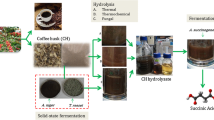Abstract
The goal of this work was to show the possibility of removing acrylamide from real foods using bacterial enzymes at relatively high temperatures. Cell-free extracts from Ralstonia eutropha AUM-01 isolated from soil collected from leaf litter on Picnic Point on the UW-Madison campus and a thermophilic strain, Geobacillus thermoglucosidasius AUT-01 isolated from soil collected from hot spring area in Montana, were used to remove acrylamide from coffee. Coffee was chosen because ~39 % of the acrylamide that people consumed is from coffee. Cell extracts containing acrylamide-degrading enzymes, which hydrolyze acrylamide to acrylic acid, were directly applied to coffee. Although acrylamide was not totally degraded at higher concentrations of coffee in water, it was totally disappeared in 100 mg coffee/10 mL ddH20, which ordinary people drink. This is the first approach for applying bacterial enzymes to real food for the removal of acrylamide.


Similar content being viewed by others
References
Abramsson-Zetterberg L (2003) The dose-reponse relationship at very low doses of acrylamide linear in the flow cytometer-based muse micronucleus assay. Mutat Res 535:215–222
Cha M, Chambliss GH (2011) Characterization of Acrylamidase Isolated from a Newly Isolated Acrylamide-Utilizing Bacterium, Ralstonia eutropha AUM-01. Curr Microbiol 62:671–678
Cha M, Chambliss GH (2012) Cloning and sequence analysis of the heat-stable acrylamidase from a newly isolated thermophilic bacterium, Geobacillus thermoglucosidasius AUT-01. Biodegradation. doi:10.1007/s10532-012-9557-6
Cheong TK, Oriel PJ (2000) Cloning of a wide-spectrum amidase from Bacillus stearothermophilus BR388 in Eschericia coli and marked enhancement of amidase expressing using directed evolution. Enzy Micro Technol 26:152–158
Cherry AB, Gabaccia AF, Senn HW (1956) The assimilation behavior of certain toxic organic compounds in natural waters. Sewage Ind Waters 28:1137
Hogervorst JG, Schouten LJ, Konings EJ, Goldbohm RA, van den Brandt PA (2007) A prospective study of dietary acrylamide intake and the risk of endometrial, ovarian, and breast cancer. Cancer Epidemiol Biomarkers Prev 16:2304–2313
Kimura T (1959) Studies on metabolism of amides in Mycobacteriaceae. J Biochem 46:973–978
Kobayashi M, Komeda H, Nagasawa T, Nishiyama M, Horinouchi S, Beppu T, Yamada H, Shimizu S (1993) Amidase coupled with low molecular-mass nitrile hydratase from Rhodococcus rhodochrous J1. Euro J Biochem 217:327–336
Lande SS, Bosch SJ, Howard PH (1979) Degradation and leaching of acrylamide in soil. J Environ Qual 8:133–137
Mottram DS, Wedzicha BL, Dodson AT (2002) Acrylamide is formed in the Maillard reaction. Nature 419:448–449
Nawaz MS, Franklin W, Campbell WL, Heinze TM, Cerniglia CE (1991) Metabolism of acrylonitrile by Klebsiella pneumoniae. Arch Microbiol 156:231–238
Nawaz MS, Franklin W, Cerniglia CE (1992) Degradation of acrylamide by immobilized cells of a Pseudomonas sp. and Xanthomonas maltophilia. Can J Microbiol 39:207–212
Nawaz MS, Khan AA, Seng JE, Leakey JE, Siitomen PH, Cerniglia CE (1994) Purification and characterization of an amidase from an acrylamide-degrading Rhodococcus sp. Appl Environ Microbiol 60:3343–3348
Pertsovich S, Guranda D, Podchernyaev D, Yanenko A, Svedas V (2005) Aliphatic amidase from Rhodococcus rhodochrous M8 is related to the nitrilase/cyanide hydratase family. Biochemistry (Moscow) 70:1280–1287
Segerbäck D, Calleman CJ, Schreoder JL, Costa LG, Faustman EM (1995) Formation of N-7-(2-carbamoyl-2-hydroxyethyl)guanine in DNA of the mouse and the rat following intraperitoneal administration of [14C]acrylamide. Carcinogenesis 16:1161–1165
Svensson K, Abramsson L, Becker W, Glynn A, Hellenäs K, Lind Y, Rosen J (2003) Dietary intake of acrylamide in Sweden. Food Chem Tox 41:1581–1586
Skouloubris S, Labigne A, De Reuse H (1997) Identification and characterization of an aliphatic amidase in Helicobacter pylori. Mol Microbiol 25:989–998
Stadler RH, Blank I, Varga N, Robert F, Hau J, Guy PA, Robert M, Riediker S (2002) Acrylamide from Maillard reaction products. Nature 419:449–450
Taeymans D, Wood J, Ashby P (2004) A review of acrylamide: an industry perspective on research, analysis, formation, and control. Crit Rev Food Sci Nutr 44:323–347
Tareke E, Rydberg P, Karlsson P, Eriksson S, Tornqvist M (2000) Acrylamide: a cooking carcinogen? Chem Res Toxicol 13:517–522
Tareke E, Rydberg P, Eriksson S, Tornqvist M (2002) Analysis of acrylamide, a carcinogen formed in heated foodstuffs. J Agric Food Chem 50:4998–5006
White JM, Jones DD, Huang D, Gauthier JJ (1988) Conversion cyanide to formate and ammonia by pseudomonad obtained from industrial wastewater. J Ind Microbiol 3:263–272
Author information
Authors and Affiliations
Corresponding author
Rights and permissions
About this article
Cite this article
Cha, M. Enzymatic control of the acrylamide level in coffee. Eur Food Res Technol 236, 567–571 (2013). https://doi.org/10.1007/s00217-013-1927-8
Received:
Revised:
Accepted:
Published:
Issue Date:
DOI: https://doi.org/10.1007/s00217-013-1927-8




